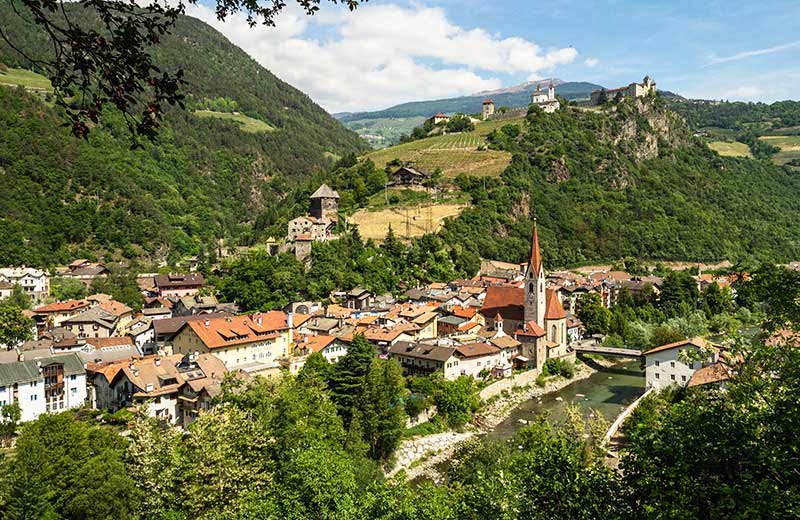Introduction to the Dolomites
The Dolomites, a striking mountain range located in northern Italy, are celebrated for their breathtaking landscapes characterized by dramatic peaks, lush valleys, and vibrant colors that change with the seasons. This UNESCO World Heritage site is part of the Southern Limestone Alps and offers some of the most spectacular natural scenery in Europe. The significance of the Dolomites extends beyond their visual appeal; they serve as a crucial destination for outdoor recreation enthusiasts. Activities such as skiing, hiking, climbing, and cycling attract visitors from around the globe, allowing them to experience the majesty of these mountains firsthand.
The geological uniqueness of the Dolomites is equally noteworthy. Composed predominantly of dolomite rock, this range exhibits distinctive formations that have intrigued geologists and nature lovers alike. The striking vertical walls and pinnacles of these mountains provide a stunning backdrop for various outdoor activities while also showcasing nature’s creative artistry through millions of years of erosion and geological evolution. The rich tapestry of flora and fauna found here further highlights the ecological importance of the region, making it a haven for biodiversity.
Culturally, the Dolomites are steeped in history, with charming villages that reflect the heritage of the area. These villages, often nestled within the valleys or perched on the mountainsides, offer a glimpse into local traditions, architecture, and ways of life. From the culinary delights featuring traditional Tyrolean dishes to the vibrant festivals celebrating local customs, the culture of the Dolomites enriches the overall experience for visitors. As we delve deeper into the mountain villages within this captivating range, it becomes evident that the Dolomites are not only a natural wonder but also a cultural treasure that deserves exploration.
Why Visit Mountain Villages?
The mountain villages nestled in the Dolomites present a unique allure that captures the hearts of many travelers. Characterized by their stunning natural scenery, these villages offer a captivating blend of architectural charm and rich cultural heritage. The traditional alpine architecture, often featuring wooden chalets adorned with colorful flowers, provides a picturesque backdrop that enchants visitors throughout the year. As travelers explore these authentic mountain settlements, they are often struck by the sense of tranquility that pervades the atmosphere, allowing for a serene escape from bustling city life.
One of the most significant advantages of visiting these off-the-beaten-path locations is the opportunity for immersion in local culture. Each mountain village boasts its distinct customs and traditions, which can often be experienced through community events, local festivals, and artisanal markets. This cultural interaction grants visitors a deeper understanding of the local way of life, fostering an appreciation for the history and traditions unique to the Dolomite region. Furthermore, the gastronomic experiences available in these villages deserve noteworthy mention. Local cuisine, often derived from age-old recipes, allows one to savor authentic dishes made from fresh, regional ingredients, an aspect that greatly enhances the travel experience.
In addition to cultural immersion and gastronomy, mountain villages in the Dolomites offer numerous outdoor activities that cater to various interests. From hiking trails that accommodate both novice and seasoned trekkers to opportunities for skiing and snowboarding in the winter months, these destinations are perfect for those seeking adventure amidst breathtaking landscapes. The varied terrain is home to rich biodiversity, making it an excellent locale for nature enthusiasts and photographers alike.
Ultimately, the combination of charming architecture, tranquil ambiance, and immersive cultural experiences make the mountain villages in the Dolomites a must-visit for any traveler looking to enrich their journey. Exploring these hidden gems reveals not only the captivating beauty of the region but also the warmth of the communities that inhabit them.
Cortina d’Ampezzo: The Pearl of the Dolomites
Cortina d’Ampezzo stands as one of the most significant and picturesque mountain villages in the Dolomites, often referred to as the “Pearl of the Dolomites.” Nestled within the heart of this UNESCO World Heritage site, Cortina has earned its reputation through a combination of stunning natural beauty and a rich history that dates back to ancient times. The village not only serves as a gateway to some of the most breathtaking landscapes in the region but also offers a plethora of recreational activities that attract visitors year-round.
The historical significance of Cortina is palpable, with its charming architecture reflecting a blend of Alpine and Italian influences. Originally an important trading post, the area has developed into a renowned tourist destination, especially since hosting the Winter Olympics in 1956. Today, the roads of Cortina are lined with luxury boutiques, fine dining establishments, and cultural sites, including the Museum of the Great War, which educates visitors about the region’s history during World War I.
For outdoor enthusiasts, Cortina d’Ampezzo is unparalleled. The destination is a hub for skiing during the winter months, boasting an extensive network of slopes and lifts that cater to all skill levels. In the warmer months, the region transforms into a paradise for hiking, with trails that range from leisurely walks to challenging climbs. Locations like the Tofana and Cinque Torri are particularly recommended for their scenic views and diverse terrain.
The gastronomy of the area also deserves attention. Visitors can indulge in local delicacies at various eateries, such as the traditional speck platter or the famous apple strudel. Whether one seeks adventure or tranquility, Cortina d’Ampezzo promises an unforgettable experience immersed in the breathtaking beauty of the Dolomites.
San Cassiano: A Hidden Gem
San Cassiano, a quaint village nestled in the heart of the Dolomites, is an enchanting destination that captivates visitors with its stunning alpine backdrop. Surrounded by towering peaks and lush green meadows, this idyllic setting offers a perfect blend of natural beauty and rich cultural heritage. The village is part of the Ladin-speaking region, where ancient traditions and local customs are preserved and celebrated. The unique Ladin culture infuses San Cassiano with a charm that is both inviting and immersive.
For adventure enthusiasts, San Cassiano serves as an excellent base for a variety of outdoor activities. The region is dotted with an extensive network of hiking trails that cater to different skill levels, allowing visitors to explore the breathtaking scenery at their own pace. The trails range from leisurely walks through meadows to challenging hikes that lead to panoramic viewpoints. In winter, San Cassiano transforms into a snow-covered wonderland, offering opportunities for skiing, snowboarding, and snowshoeing. The nearby Alta Badia ski area is renowned for its groomed slopes and well-maintained infrastructure, making it a sought-after destination for winter sports lovers.
The culinary scene in San Cassiano is equally remarkable, showcasing a delightful fusion of Ladin and Italian flavors. Visitors can indulge in traditional dishes such as speck, canederli, and homemade pasta, often accompanied by a selection of local wines. Several family-run restaurants and alpine huts provide an authentic dining experience, where guests can savor the warmth of Ladin hospitality.
In summary, San Cassiano is an excellent destination that beautifully combines stunning alpine scenery, rich local traditions, and a plethora of outdoor adventures. Whether you seek adrenaline-pumping activities or a tranquil retreat in nature, this hidden gem in the Dolomites promises an unforgettable experience.
Val Gardena: A Valley of Wonders
Val Gardena, nestled in the heart of the Dolomites, is a spectacular valley renowned for its breathtaking landscapes and rich cultural diversity. With its striking mountains, lush meadows, and charming villages, Val Gardena offers an idyllic setting for visitors seeking nature’s beauty and outdoor adventures. The valley is comprised of three picturesque villages: Ortisei, Santa Cristina, and Selva di Val Gardena, each providing a unique experience and an opportunity to explore the cultural heritage of this stunning region.
Outdoor enthusiasts will find Val Gardena a haven for year-round activities. In winter, the valley transforms into a ski paradise, boasting access to the vast Dolomiti Superski area with over 1,200 kilometers of ski slopes. Skiing, snowboarding, and winter hiking are some of the exciting winter activities available in this region. As the snow melts and spring arrives, hiking trails bloom with wildflowers, inviting trekkers to discover scenic routes that offer panoramic views of the surrounding peaks. Summer and fall see the valley teeming with mountain biking, rock climbing, and other outdoor pursuits.
Val Gardena is also notable for its local artisans and traditional crafts. The valley is famous for its woodcarving art, a unique and culturally significant tradition. Visitors can explore workshops and galleries showcasing beautifully crafted wooden sculptures and intricate carvings, offering insight into the craftsmanship that thrives in this area. Another aspect of the local culture is the culinary experience, where you can indulge in hearty Tyrolean dishes and delicious local wines. Among the must-try specialties is speck, a cured ham, and canederli, traditional dumplings prepared with bread and various ingredients.
In conclusion, Val Gardena stands out not only for its natural beauty but also for its vibrant culture and diverse recreational opportunities. Whether you seek adventure in the great outdoors or simply wish to immerse yourself in local traditions, this enchanting valley has something for everyone.
Lauterbrunnen: The Village with a Timeless Charm
Nestled in a spectacular valley surrounded by towering cliffs, Lauterbrunnen is a village that epitomizes the charm of the Swiss Alps. Renowned for its breathtaking waterfalls, including the iconic Staubbach Falls, which cascades nearly 300 meters from a cliff edge, Lauterbrunnen offers visitors a mesmerizing outdoor spectacle. The waterfalls, combined with the lush green meadows and rugged mountain backdrop, create a picturesque scene that draws nature lovers and photographers alike.
The valley itself is a UNESCO World Heritage site and is revered for its well-preserved cultural heritage. Traditional wooden chalets line the village streets, showcasing a unique architectural style that has remained largely unchanged over the years. These structures add to the timeless atmosphere, inviting visitors to stroll through and admire the craftsmanship that reflects the village’s rich history. Moreover, Lauterbrunnen serves as an excellent base for exploring the surrounding regions, including the Lauterbrunnen-Mürren and Jungfrau areas, both famous for their dramatic mountain scenery and thrilling hiking trails.
For those looking to experience the region on foot, Lauterbrunnen offers an array of hiking paths that cater to various skill levels. Whether you desire a leisurely walk along the valley floor or a challenging trek up to nearby peaks, the surrounding landscape provides ample opportunities for adventure. Notable trails include the route to the charming village of Mürren, which rewards hikers with panoramic views of the Eiger, Mönch, and Jungfrau mountains.
Accessibility is another factor contributing to Lauterbrunnen’s appeal. Conveniently connected by train and cable car to major cities like Interlaken, it is an easily reachable destination for travelers. Furthermore, the village hosts several local festivals throughout the year, celebrating traditional Swiss culture with music, food, and community activities, further enhancing its enchanting atmosphere. Whether you are drawn by the natural beauty or the rich heritage, Lauterbrunnen is a must-visit destination in the Dolomites.
Brixen: A Blend of Culture and Nature
Brixen, or Bressanone, is a picturesque town nestled in the heart of the Dolomites, known for its captivating historical architecture and stunning landscapes. This destination emerges as a unique amalgamation of Italian elegance and Tyrolean tradition, offering visitors an enriching experience that harmoniously combines culture and nature. The town’s medieval architecture is prominently displayed in landmarks such as the Bishop’s Palace and the Cathedral of Brixen, which are essential sites for any traveler interested in history and architecture.
The cultural blend of Italian and Tyrolean influences is evident in Brixen’s vibrant local festivals, culinary delights, and artistic expressions. The town celebrates various festivals throughout the year, showcasing traditional Tyrolean music and dance, which provide a unique insight into the area’s rich cultural heritage. Culinary enthusiasts can indulge in an array of local dishes, including canederli (bread dumplings) and speck, which reflect the region’s culinary diversity that boasts Italian flair intertwined with Tyrolean rusticity.
Outdoor enthusiasts will find a plethora of year-round activities in and around Brixen. In the winter, nearby ski resorts offer excellent slopes for skiing and snowboarding, while a network of well-marked trails invites hikers and mountain bikers in the warmer months. The stunning natural surroundings, including the scenic Plose Mountain, provide visitors with breathtaking views and opportunities for both leisurely walks and more challenging treks. Alongside these outdoor adventures, the town’s charming cafés and shops make for perfect spots to rest and immerse oneself in the local atmosphere.
Ultimately, Brixen stands out as a destination that not only highlights the natural beauty of the Dolomites but also celebrates the harmonious cultural intersection that defines this remarkable town. Visitors can expect to leave with lasting memories of both stunning landscapes and rich cultural experiences.
Civetta: A Heart for Outdoor Enthusiasts
The Civetta area, known for its breathtaking vertical cliffs and unique rock formations, stands as a beacon for outdoor enthusiasts seeking adventure in the heart of the Dolomites. This stunning mountain range offers a plethora of activities throughout the year, catering to various skill levels and preferences. Climbing enthusiasts will find the region particularly inviting, as it boasts numerous climbing routes that challenge even the most experienced alpinists while simultaneously providing opportunities for beginners to hone their skills in a picturesque setting.
In the winter months, Civetta transforms into a skier’s paradise. The well-maintained slopes provide options for both alpine skiing and snowboarding, complemented by an impressive network of cross-country skiing trails. With facilities catering to families and beginners, visitors can enjoy the thrill of skiing while soaking in the stunning alpine views. After a day on the slopes, unwind in one of the many cozy lodges or après-ski bars available in the nearby villages.
For mountain biking enthusiasts, the summer season in Civetta presents an array of trails that weave through verdant meadows and dense forests. These biking paths vary in difficulty, ensuring that riders of all levels can explore the breathtaking landscape. Many local companies offer guided tours, enabling participants to discover hidden gems and enjoy the rich flora and fauna of the area.
When considering accommodations, various charming villages around Civetta provide options for every taste and budget. From quaint bed and breakfasts to fully equipped apartments, visitors can find the perfect place to rest after a day of adventures. Dining in the region is equally delightful, with many restaurants offering local cuisine accompanied by stunning mountain views, ensuring a fulfilling culinary experience that complements the outdoor excitement.
Plan Your Trip: Best Times to Visit
When planning a visit to the Dolomites, understanding the best times to explore this breathtaking region is crucial. The Dolomites, with their stunning landscapes and unique culture, offer a multitude of experiences across different seasons. Generally, the ideal times to visit are late spring (May to June) and early autumn (September to October). During these months, weather conditions are pleasant, and the views are striking, making it perfect for hiking, biking, and photography.
Summer (July to August) is another popular time to visit, particularly among families and outdoor enthusiasts. However, tourists should be prepared for larger crowds and higher accommodation prices. Winter (December to March) offers a different allure, attracting ski lovers to its renowned slopes. Visiting during the winter provides a unique perspective of the Dolomites when they are blanketed in snow, transforming the landscape into a winter wonderland.
When organizing your itinerary, consider the diverse activities available. For hiking enthusiasts, various trails cater to different skill levels, and guided tours can enhance your understanding of the local flora and fauna. Cultural experiences such as visiting local markets, indulging in traditional cuisine, and attending local festivals enrich your travel experience, allowing for an immersive journey into the region’s heritage.
Transportation options within the Dolomites are plentiful. Renting a car offers the most flexibility for exploring remote villages; however, public transportation services such as buses connect major towns and tourist sites. To ensure sustainable travel practices, consider using public transport, staying in eco-friendly accommodations, and respecting local wildlife and natural habitats throughout your visit. By planning wisely and considering the best times to visit, you can create an enriching experience that showcases the quintessential beauty of the Dolomites while leaving a minimal footprint on the region.







